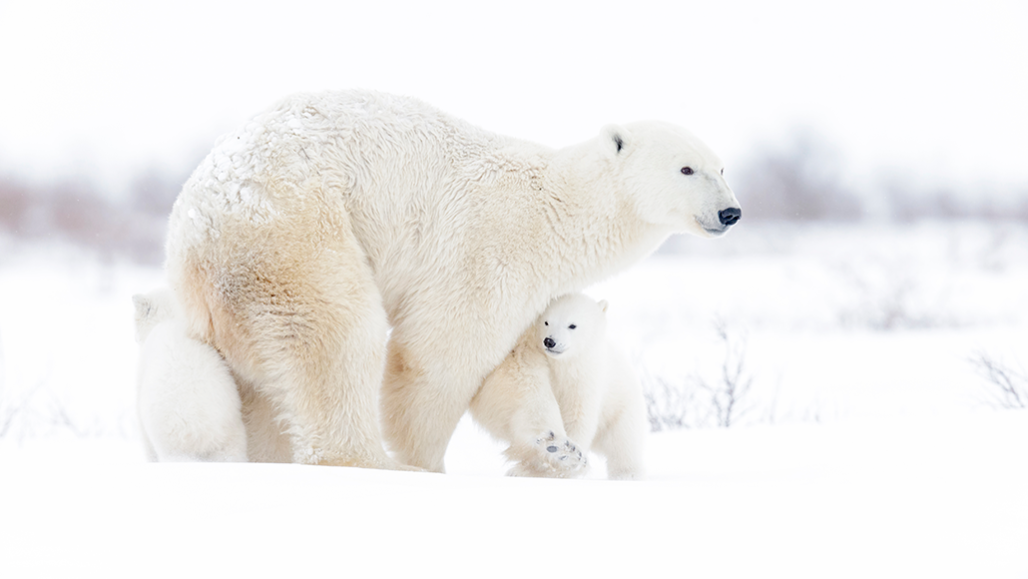Antarctica: A continent mostly covered in ice, which sits in the southernmost part of the world.
Arctic: A region that falls within the Arctic Circle. The edge of that circle is defined as the northernmost point at which the sun is visible on the northern winter solstice and the southernmost point at which the midnight sun can be seen on the northern summer solstice. The high Arctic is that most northerly third of this region. It’s a region dominated by snow cover much of the year.
bowhead: A type of baleen whale that lives in the high Arctic. Roughly 4 meters (13 feet) long at 900 kilograms (2,000 pounds) at birth, it grows to an enormous size and may live well over a century. Adults can span 14 meters (40 feet) and weigh up to 100 metric tons. They use their massive skulls to break through ice to breathe. Lacking teeth, they sieve the water, straining out tiny plankton and fish to sustain their huge size.
climate change: Long-term, significant change in the climate of Earth. It can happen naturally or in response to human activities, including the burning of fossil fuels and clearing of forests.
ecologist: A scientist who works in a branch of biology that deals with the relations of organisms to one another and to their physical surroundings.
erosion: (v. erode) The process that removes rock and soil from one spot on Earth’s surface, depositing it elsewhere. Erosion can be exceptionally fast or exceedingly slow. Causes of erosion include wind, water (including rainfall and floods), the scouring action of glaciers and the repeated cycles of freezing and thawing that occur in many areas of the world.
expedition: A journey (usually relatively long or over a great distance) that a group of people take for some defined purpose, such as to map a region’s plant life or to study the local microclimate.
flammable: Something that can burn (go up in flames) easily.
freshwater: A noun or adjective that describes bodies of water with very low concentrations of salt. It’s the type of water used for drinking and making up most inland lakes, ponds, rivers and streams, as well as groundwater.
greenhouse gas: A gas that contributes to the greenhouse effect by absorbing heat. Carbon dioxide is one example of a greenhouse gas.
habitat: The area or natural environment in which an animal or plant normally lives, such as a desert, coral reef or freshwater lake. A habitat can be home to thousands of different species.
latitude: The distance from the equator measured in degrees (up to 90). Low latitudes are closer to the equator; high latitudes are closer to the poles.
longitude: The distance (measured in angular degrees) from an imaginary line — called the prime meridian — that would run across Earth’s surface from the North Pole to the South Pole, along the way passing through Greenwich, England.
methane: A hydrocarbon with the chemical formula CH4 (meaning there are four hydrogen atoms bound to one carbon atom). It’s a natural constituent of what’s known as natural gas. It’s also emitted by decomposing plant material in wetlands and is belched out by cows and other ruminant livestock. From a climate perspective, methane is 20 times more potent than carbon dioxide is in trapping heat in Earth’s atmosphere, making it a very important greenhouse gas.
permafrost: Soil that remains frozen for at least two consecutive years. Such conditions typically occur in polar climates, where average annual temperatures remain close to or below freezing.
planet: A celestial object that orbits a star, is big enough for gravity to have squashed it into a roundish ball and has cleared other objects out of the way in its orbital neighborhood.
potent: An adjective for something (like a germ, poison, drug or acid) that is very strong or powerful.
sea: An ocean (or region that is part of an ocean). Unlike lakes and streams, seawater — or ocean water — is salty.
species: A group of similar organisms capable of producing offspring that can survive and reproduce.
tundra: A cold, usually lowland area in far northern regions. The subsoil is permanently frozen. In summer, a tundra's top layer of soil thaws and can support low-growing mosses, lichens, grasses, shrubs and trees (some only a few centimeters high).
zooplankton: Small organisms that drift in the sea. Zooplankton are tiny animals that eat other plankton. They also serve as an important food source for other marine creatures.

